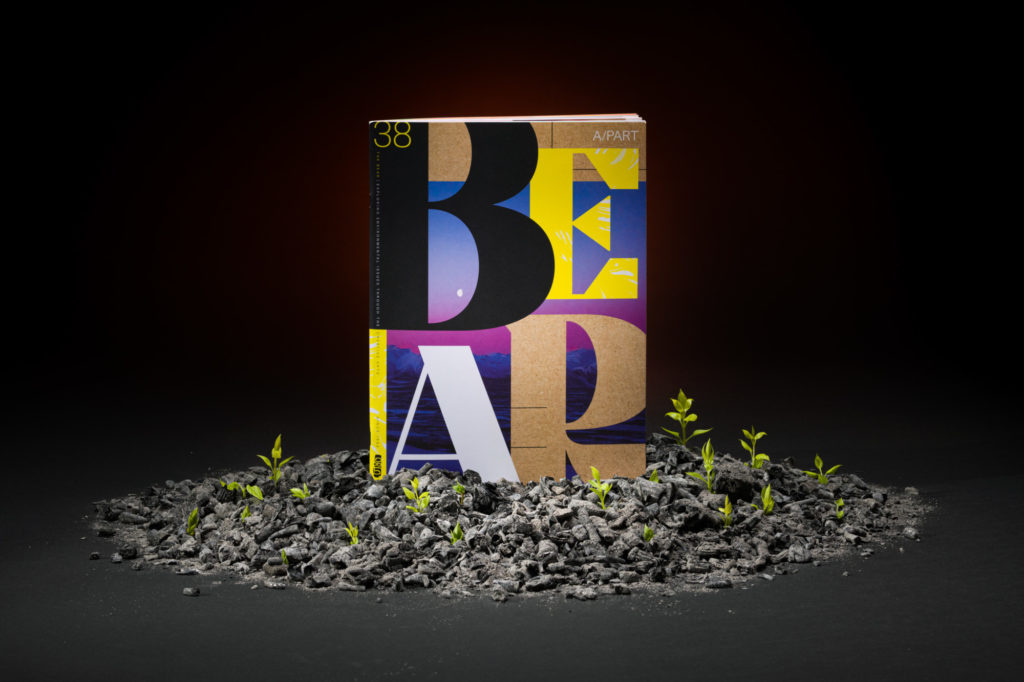These pages were designed as a time capsule brimming not only with art, but also with stories of the humans making art over the past year (2020-21). Rather than paint a broad picture, they are meant to reveal bright glimpses of what it looks like to fight, to grieve, to celebrate, and to take up space. This issue grapples with a sense of urgency at the intersections of art, identity, and the environment in an expansive sense; through the words and work of artists, designers, organizers, storytellers, and poets.

(photographed by Mario Gallucci)
A/PART is the latest issue (#38!) of a magazine that started as the Bear Essential and became the Bear Deluxe—one piece of [this] nonprofit, volunteer-run organization, Orlo, with the mission to explore art and the environment on the brink. The Bear has survived many evolutions since 1993. Our aim has always been to provoke and explore. We have been fortunate to find fans among writers and artists, punks and academics, artists and instigators who are interested in issues of the environment and a sense of place as a nexus of culture. A/PART is a labor of love, born from an endeavor to re-vision this project and to consider what our legacy could be…
Our rapidly escalating climate crisis highlighted the persistent need for a stronger perspective in climate justice; in particular, one driven by more creative folx whose communities are not only disproportionally impacted by environmental crisis, financial obstacles, and other products of systemic racism, but who have been leading the efforts to correct course. The Bear needed to look forward, even as we look at our own histories in this work. In early 2020, as Portland and our region went into lockdown in response to the COVID-19 pandemic, we wanted to find a way to sponsor artists in a time of hardship. We saw an opportunity to decentralize our editorial model in a way that would be in line with our vision for a more multifaceted publication. We wanted to experiment, to see if we could cultivate an energy that matched the work we were trying to do behind the scenes.
So, we asked five creators to each serve as sponsors, curators, and connectors to five artists who inspire them, and redistributed the funding for this issue among the sponsors and featured artists. Our sponsors drove the editorial perspective, with individual ownership over how they would connect and with whom. Some chose to have actual conversations or written exchanges, others wanted to more simply sponsor and highlight a body of work and an artist they deeply respect. It was a chance for some people who already had relationships to reconnect; in other cases, to build new relationships.
And as we started this work, the pandemic took hold and spread. Inequities moved even more into the spotlight as protests escalated across the country following the murder of George Floyd and too many others. Then came wildfires that devastated much of the West. At each turn, our communities encountered another far-reaching crisis, facing risks to their lives in multiple ways. Though A/PART is not a reaction, it cannot be separated from a year that has made creative work incredibly challenging, even while highlighting its vital role in nourishing, fighting, communicating, processing, and living.
What does it look like to be making art here, now? For some, like Chad Brown (page 34), it means learning to stay uncomfortable but ready, for the sake of change we may not see in our lifetimes, through community building and restoration advocacy in threatened outdoor spaces. For Estella Tse (page 44),it means building imaginative worlds for escape through augmented reality-amplified illustration. It can be rooted in activism on the front lines of climate justice, as in the work of Ka’ila Farrell-Smith (page 26), who paints with harvested wild pigments and found objects that connect deeply to the land she defends. Forging connections between Indigenous research and the gallery world is central to RYAN! Feddersen’s work (page 20), which includes art in the streets activated by nature. Illuminating and educating, photojournalist Joe Whittle (page 12) reminds us to listen to the peaceful warriors who have been serving as caretakers of this land and protectors of the future. Maya Vivas (page 9) sharply focused for me the potential for place-based art to reflect and process pain, memory; to offer escape, imagine possibilities. The future beats in jayy dodd’s poetry and visual work (page 4) that shimmers, in my eyes, with both the harsh reality and the celebration of being in one’s own skin. And as jayy writes, if you see it differently, maybe you misunderstood correctly.
At best, we had hoped to be a catalyst, offering possibilities for inspiration and action, setting ideas in motion, and synthesizing something wild and free and larger than the sum of these separate pages. What has emerged here is more essential—more specific, at times more painful, and more beautiful than I imagined. This is because we are not the heart of it, but a part. Thank you for spending time with us. —Kristin Rogers Brown, co-creative director, A/PART
Note: This letter is reprinted from issue #38 of The Bear magazine, A/PART. You can order your copy directly by sending $10 via paypal here to cover shipping and handling. As always, we aim to be wild and free.